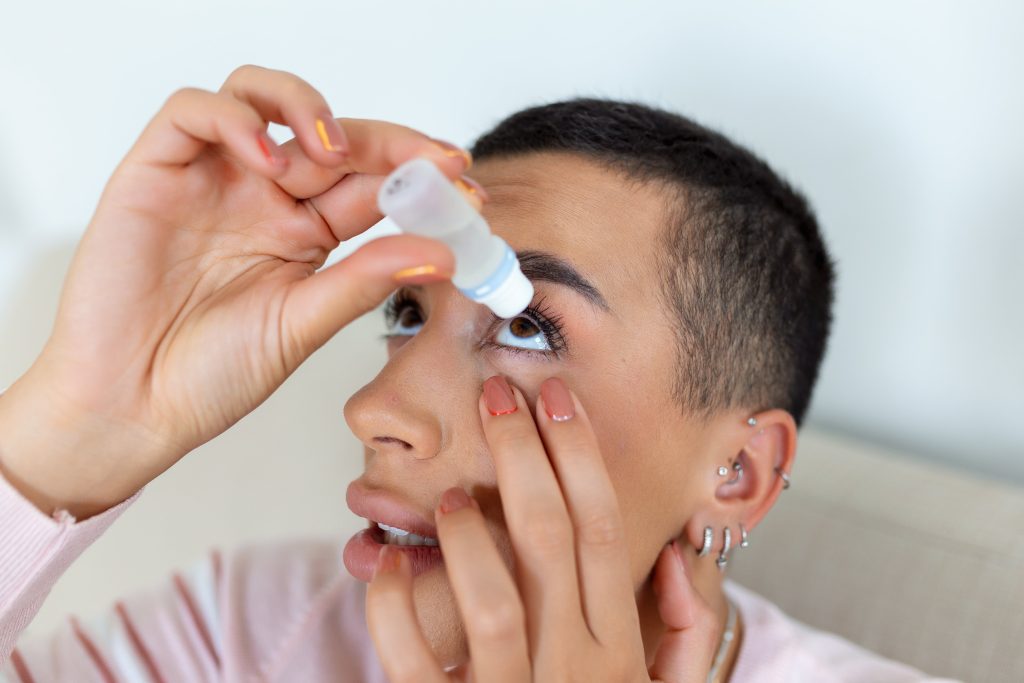After undergoing cataract surgery, proper care and follow-up are crucial for a smooth recovery. One essential aspect of postoperative care involves the use of prescribed eye drops. You may be advised to use these eye drops before and after your cataract surgery to facilitate your healing.
Different eye drops for cataract recovery serve various purposes. What are the different eye drops, and what purpose do they serve in aiding with cataract recovery?
1. Steroid Eye Drops
Steroid eye drops are often prescribed to control inflammation following cataract surgery. By addressing inflammation, these drops also mitigate the risk of macular oedema, a condition characterised by swelling in the macula, which is responsible for the eye’s detailed vision. If macular oedema is not managed properly, it can lead to blurred vision and hinder recovery following cataract-removal surgery.
You may be prescribed to use these eye drops twice to four times daily for two to six weeks after your surgery. However, depending on your progress, the eye specialist may recommend you cut back on the frequency of your usage as time goes on. Know that when you use steroid eye drops, it is important to adhere to your eye doctor’s prescription to prevent any negative side effects.
For further insight, learn more about the effects of steroids on the eyes.
2. Antibiotic Eye Drops
To prevent infection and ensure the surgical site remains sterile, antibiotic eye drops are typically included in the postoperative regimen. These drops help to fend off bacteria that could potentially lead to complications, safeguarding the eye’s health as it heals. As such, your cataract surgeon may advise you to start using antibiotic eye drops a few days before your surgery. After the surgery, you will be asked to continue using the eye drops for one to two weeks as postoperative eye care.
3. NSAID Eye Drops
Nonsteroidal anti-inflammatory drugs (NSAIDs) in eye drop form may also be prescribed after cataract eye surgery in Singapore. Usually, NSAID eye drops are prescribed as an alternative to steroid eye drops after the surgery, depending on your underlying medical condition.
Moreover, NSAID eye drops can keep pupils dilated during cataract surgery to prevent complications related to vitreous loss, zonular fibre disruption, and remnant lens material.
Should the cataract surgeon advise you to use NSAID eye drops, typically, you will be prescribed to use them two to four times per day for about one month.

How to Put Eye Drops in Your Eyes for Proper Post-Surgery Care
Proper administration of eye drops is paramount to ensure their optimal effectiveness in aiding your cataract recovery journey. Here’s a breakdown of the process:
- Wash Your Hands Thoroughly: Start washing your hands meticulously with soap and water. This step is important to prevent any potential introduction of bacteria or contaminants into your eyes.
- Shake the Eye Drop Bottle: Before using the eye drops, gently shake the bottle to thoroughly mix the solution. This helps to maintain the potency and consistency of the medication.
- Tilt Your Head Back: Tilt your head backward slightly and look upward toward the ceiling. This position facilitates easier access to your eye and smoother application of the drops.
- Create a Small Pocket: Using one hand, gently pull down your lower eyelid to have a small pocket between your eyelid and eye. This pocket serves as a reservoir for the eye drops, ensuring the medication reaches its intended target.
- Hold the Bottle Upside Down: With the other hand, hold the eye drop bottle upside down directly above the eye. To prevent contamination, avoid having the tip of the bottle touch your eye or any surrounding surfaces.
- Release One Drop: Squeeze the bottle gently to release a single drop of the medication into the small pocket formed by the lower eyelid. Aim for the centre of the pocket to ensure proper delivery of the eye drops.
- Close Your Eye Gently: After instilling the drop, close your eye gently for a moment. This enables the medication to spread evenly across the surface of the eye and facilitates absorption.
- Wipe Away Excess Liquid: If any excess liquid escapes from the eye or eyelid, use a clean tissue to gently dab it away. Avoid rubbing your eyes, as this can cause irritation or dislodge the medication.
- Repeat for the Other Eye: If your doctor has prescribed drops for both eyes, repeat the entire process for the second eye following the same steps outlined above.
Importance of Follow-Up Check-Ups
While diligent use of prescribed eye drops and adherence to postoperative instructions are essential components of recovery, regular follow-up appointments with your eye specialist are equally crucial. These appointments allow your eye specialist to monitor your progress, address any concerns, and make necessary adjustments to your treatment plan.
For more information, check out our guide on everything you need to know about cataract surgery recovery.

Dr. Christopher Khng, specializes in Complex Cataract and Anterior Segment Reconstruction Surgery, in particular, Iris Reconstruction and surgery for Aniridia. His other areas of expertise include Complex Lens surgery, New Lens and Phacoemulsification technologies, Refractive surgery, Phakic IOLs (the Implantable Collamer Lens, ICL), and small-incision, topical anesthesia phacoemulsification cataract surgery. Dr. Khng is a member of the Singapore Medical Association (SMA), a Fellow of the American Academy of Ophthalmology, the American Society of Cataract and Refractive Surgery (ASCRS), and the European Society of Cataract and Refractive Surgery (ECSRS). He is registered with the Singapore Medical Council (SMC) in Singapore and with the General Medical Council (GMC) for practice in the United Kingdom.

